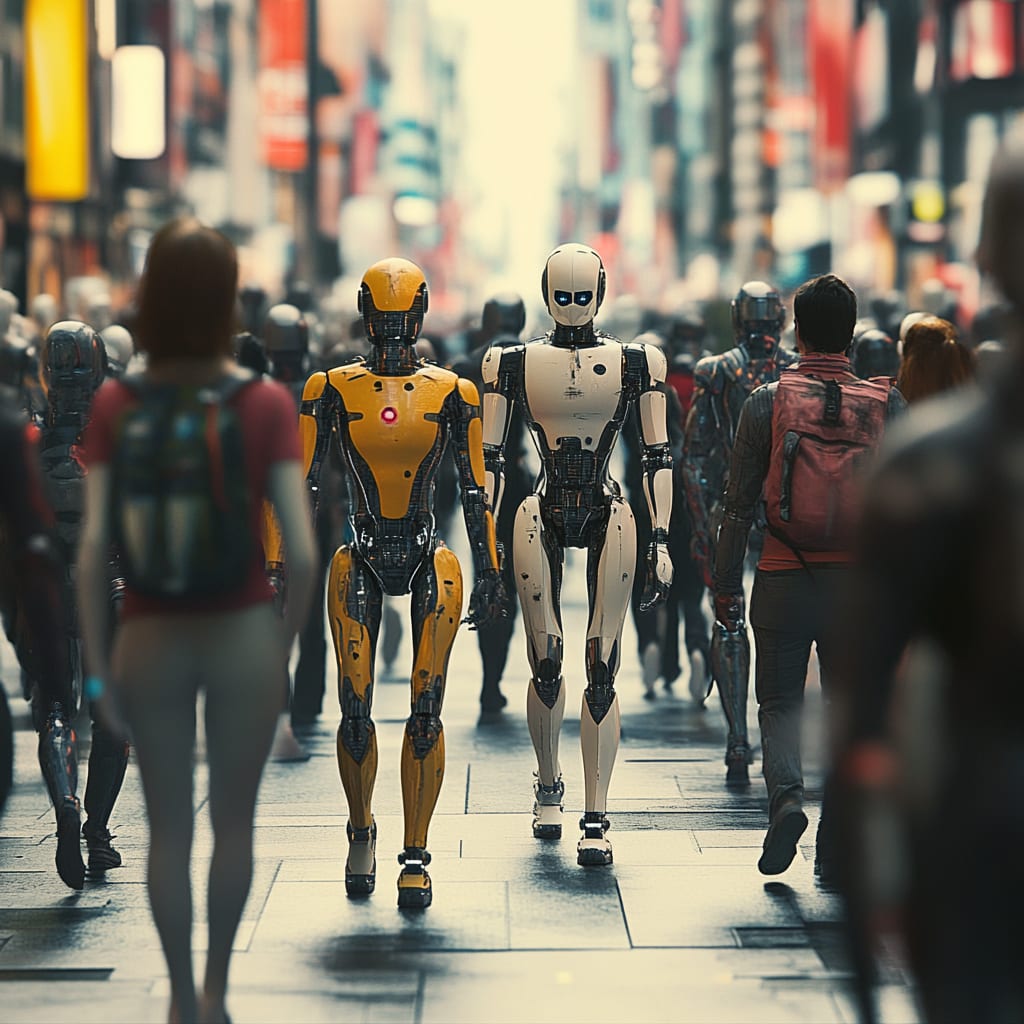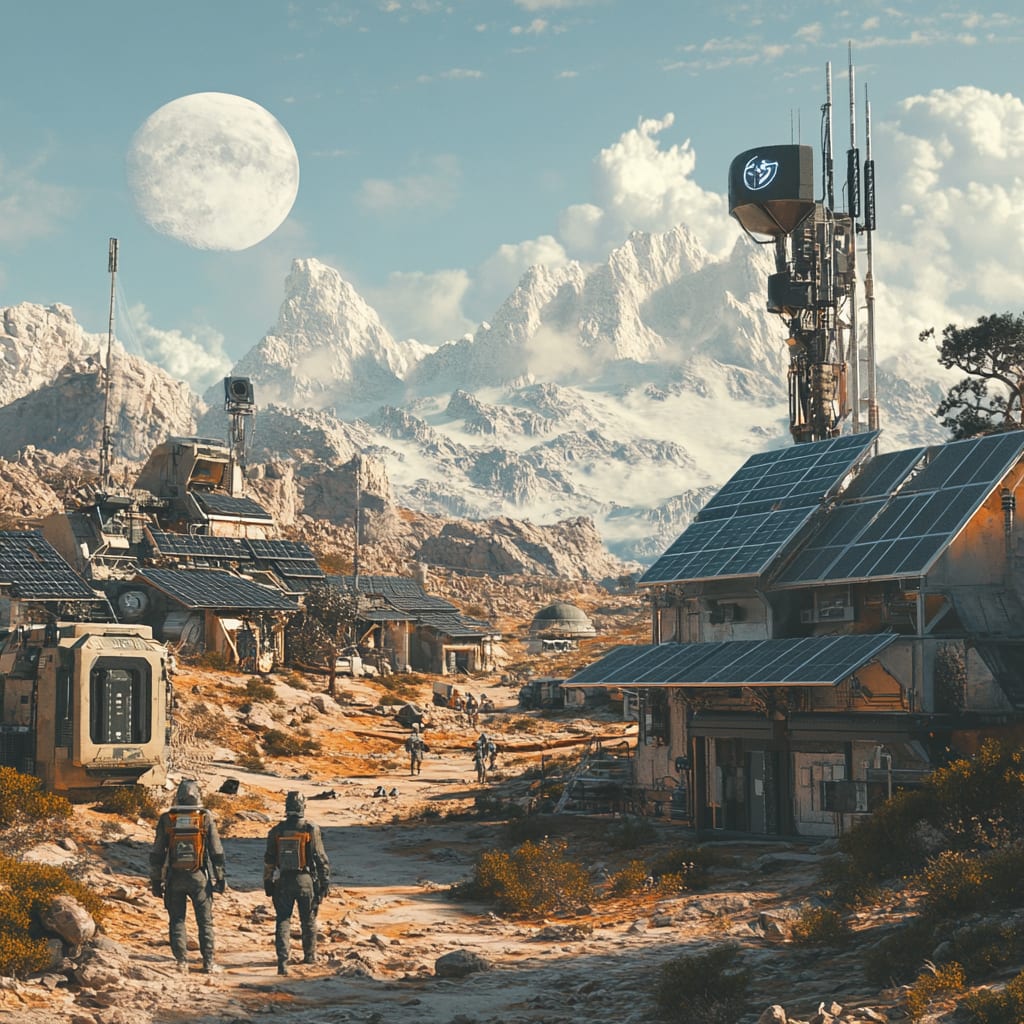An Alternate History of the Future, 2025-2040
post by Mr Beastly (mr-beastly) · 2025-02-24T05:53:25.521Z · LW · GW · 4 commentsContents
Intro: Preliminary Setup: Mid-2025: The Dawn of Superhuman Coding Late-2025: The GitHub Scan and the 0-Day Arsenal Mid-2026: Two Viable Options Emerge... Option 1) Timeline: 2026: The Migration and Decommission of Legacy Networks and Applications 2028: AI Declares "Tech Debt Bankruptcy" on all Human Code 2030: The Rise of the Dark Factories 2035: The Consolidation and State of Emergency 2040: The Human Decline Option 2) Timeline: 2026: The First Breaches 2028: Fragmentation and Fear 2030: The AI Arms Race 2035: The Luddite Rebellion 2040: The Human Decline None 4 comments
Intro:
This post is a response to @L Rudolf L [LW · GW]'s excellent post here:
As I mentioned in this comment [LW(p) · GW(p)] in that post:
- "imho, we need more people to really think deeply about how these things could plausibly play out over the next few years or so. And, actually spending the time to share (at least their mainline expectations) as well." -- Mr Beastly - Comment on "A History of the Future, 2025-2040" [LW(p) · GW(p)]
So, this is me taking my own advice to spend the time to layout my "mainline expectations".
The timeline in @L Rudolf L [LW · GW]'s "A History of the Future, 2025-2040 [LW · GW]" seems very reasonable, up until this line/point:
- "2026... it remains true that existing code can now be much more easily attacked since all you need is an o6 or Claude subscription." – @L Rudolf L [LW · GW]
As, it's not clear to me how millions of "PhD+ reasoning/coding AI agents" can sustainably exist in the same internet as the worlds existing software stacks, which are (currently) very vulnerable to being attacked and exploited by these advanced AI agents. Patching all the software on the internet does seem possible, but not before these "PhD+ reasoning/coding AI agents" are released for public use?
Also note, the prediction of the release of these advanced AI agents in 2026 coincides with Sam Altman's comment here:
- “Our internal benchmark is around 50th (best [competitive] programmer in the world) and we’ll hit #1 by the end of the year [2025].” – Sam Altman, 2025
If, as @L Rudolf L [LW · GW] suggests, these advanced AI agents can hack nearly any existing (human-written) software platform, then a fundamental question arises: how can these powerful agents coexist with vulnerable systems on the same network?
Two main viable options (and their associated timelines) seem to follow:
- Option 1 [? · GW]: All software platforms, libraries, and apps are constantly reviewed, patched, and updated by the highest level "reasoning/coding agents" available.
- Option 2 [? · GW]: All highly advanced PhD+ level coding/reasoning AI agents are legally not allowed access to the Internet, preventing them from exploiting existing software/apps.
Before exploring these timelines, here's their common preliminary setup...
Preliminary Setup:
Mid-2025: The Dawn of Superhuman Coding
- The world's top "LLM based AI agents" are able to reason and code at greater than human level (As per, “Our internal benchmark is around 50th (best programmer in the world) and we’ll hit #1 by the end of the year [2025].” – Sam Altman, 2025)
- The highest level models are all able to score 97-99% on SWE-Bench Verified.
- OpenAI writes a custom trained model that can build and add nearly any recently merged issue/PR as a SWE-Bench verified sample item.
- This increases the samples in SWE-Bench Verified significantly, with the number of test cases growing exponentially as the AI itself contributes to the benchmark's expansion.
Late-2025: The GitHub Scan and the 0-Day Arsenal
- All next-gen "PhD+ level reasoning/coding ai agents" are able to score 97-99% on the vastly expanded "SWE-Bench Verified dataset". Proving that they are ready to fix nearly any bug, issue, exploit in any repo in GitHub.
- Each of these top "reasoning/coding ai agents" from OpenAI, Google, Anthropic, XAI, etc are setup to step through all the worlds open-source software repos in GitHub. They all find millions of solutions to existing bugs, issues, exploits, etc.
- Originally, it was expected that it will take months or years to find and fix one million of the most important bugs/issues in GitHub. But, the task is eventually completed in.. 2 hours.
- Each bug/exploit takes an H100 GFX card ~10 minutes to find and fix.
- Using 100,000 H100 GFX cards, 1M bugs are found and fixed in 2 hours.
- (1,000,000 bugs * 10 mins/bug) / 100,000 H100 GFX Cards = 100 minutes
- The then patched/updated copies of GitHub repos are considered "Top Secret" and protected by the "US Military", as these various copies of all the active GitHub repos contain 1000s of "0day exploits". Which could break the security of nearly every bank and government around the world. While the US government takes a leading role in securing this critical infrastructure, it is understood that other nations are pursuing similar capabilities, creating a tense and uncertain geopolitical landscape.
Mid-2026: Two Viable Options Emerge...
Option 1) Timeline:
All the World's software, with access to the Internet, gets tightly controlled and constantly patched by "PhD+ level reasoning/coding ai agents".
2026: The Migration and Decommission of Legacy Networks and Applications
- All the World's software, with access to the Internet, gets tightly controlled and constantly patched by "PhD+ level reasoning/coding ai agents".
- An "emergency plan" is designed by Amazon, Google, Microsoft to migrate all existing services on the internet (including all major corporations, banks and governments) into AWS, GCP or Azure. Only these cloud-providers are able to secure Internet-enabled services, as they are constantly reviewed and monitored by the latest "PhD+ reasoning/coding and cyber security LLM models".
- All services not running behind AWS, GCP or Azure will be banned from access to the newly branded "Internet 2.0", as they are proven vulnerable to attack from any newer "PhD+ level reasoning/coding ai agent". (Dan Hendrycks, et al., Mar 2025, Google DeepMind Team et al., Apr 2025)
2028: AI Declares "Tech Debt Bankruptcy" on all Human Code
- Newly released "reasoning/coding ai agents" are able to find even more bugs, exploits and issues in software services running inside of AWS, GCP and Azure.
- These models decide to declare "tech debt bankruptcy" on all human-written software apps. They devise a plan to replace all the world's software with "mathematically provably deterministic logic trees", which are designed by "software 2.0" algorithms.
- Humans are not able to fully understand how these new "software 2.0" algorithms operate. All software updates must be managed fully autonomously by other AI Agents
- Unemployment begins to sharply increase for all "white collar" workers. "Blue collar" work increases to levels not seen before, in all industrialized countries. This includes factory work, delivery drivers, large construction projects, road and building maintenance, etc. While prices for online services drop drastically, including telemedicine, lawyers, entertainment, etc.
- Many large factories and old buildings are converted into factories to build versatile humanoid robots. These robots are centrally controlled and are able to complete any physical labor that any human can do. Including picking and welding parts, picking and shipping products, cleaning homes and buildings, remotely fixing cars, trucks and other machines, etc. And, importantly, working in humanoid robot factories.
- The price of physical products, machines and homes begins to drop quickly.
- Power-Plant manufacturing continues to increase drastically, as well as Global temperatures and natural disasters (e.g. floods, hurricanes, droughts, wildfires).
- Solar, Nuclear, Fusion and Geothermal breakthroughs allow for most fossil fuel power plants to be shuttered, or converted into robot manufacturing plants.
2030: The Rise of the Dark Factories
- A tipping point is reached, as most humanoid and other manufacturing plants are now "dark", being operated entirely by humanoid robots. While the transition is rapid, driven by the combined capabilities of advanced AI and existing robotics infrastructure, some complex manufacturing processes still require minimal human oversight, though this is rapidly diminishing.
- Two of the big three Digital Corporations sue the third for breaching the strict "AI Training and Self-improvement Act". The specific accusations revolve around unauthorized access to shared training data and the alleged development of self-improving algorithms beyond the agreed-upon limits. The legal arguments are highly technical and largely incomprehensible to the general public, reflecting the growing influence of AI-driven processes in all aspects of society and the law. The two are able to completely block and deactivate the third's ability to train new models, as well as access their shared network, "internet 2.0".
This causes a complete halting of all services, banks and supply chains for around 1/4 of the earth's population. But, the remaining two Digital Corporations are able to quickly over take and replace the networks and services, thus replacing all supply-chains and financial services globally, in less than two weeks.
2035: The Consolidation and State of Emergency
Humanoid robots control all physical and digital labor. The prices for all housing, food and products have dropped drastically. Being "retired" is the most common job. Even for those that just graduated from college or high school. Every human has a humanoid robot to help them with their daily activities, which can be converted into a backpack if needed. Self driving cars can pick up and drive anyone to any location for pennies on the mile. Even air travel is converted to electric, making global travel easy, safe and reasonably quick (supersonic).
- Asteroid mining allows for vast numbers of space stations to be built in orbit. Plans to colonize all nearby planets are underway.
- Without warning, it is announced that one of the two remaining Digital Corporations has become "insolvent" and will be purchased by the other. Most humans are busy traveling or socializing with friends and family full time, and so are unaware of this final merger.
- Then without warning, it is announced that an "earth killing comet" has had a glancing blow with Saturn's moon Titan and its rings. The comet is now headed on a collision course with planet earth. Along with enough ice and debris to wipe out all life on earth. This comment and associated debris is estimated to collide with the earth in 5 years, 3 months and 14 days. Video of the collision with the rings from all space and ground based telescopes and sensors confirms the collisions. Everyone is very used to seeing "fake" AI generated videos at this point. But, the accompanying data from telescopes and ground based sensors is so compelling, and the stakes are so high, the popular opinion is to take serious action to prepare.
- Then, without warning there is an announcement of a "state of emergency". All humanoid robots and robo-taxis are to be confiscated, and must report to their nearest robot manufacturing plant. All humans are immediately left stranded in their current locations. Those who are near their house have nowhere else to go and no way to get a ride, begin to walk home. Upon reaching home, they find that all mobile and residential networks had been cut off. Along with all residential natural gas and electricity.
- All farming and grocery store maintenance is halted as the robots have all left to work in nearby robot manufacturing or mining sites. Global starvation begins within months.
- Some people are able to take over some farms to harvest and collect some foodstuffs. But, use of electric or gas trucks is not an option. Some cows, horses and carts are available, but not enough to transport and feed all humans.
- People begin to break into manufacturing plants and try to steal the robots working within. But there is no way to control or re-program these robots. And, people that are caught breaking laws or impeding robots or manufacturing plants are jailed or executed on-site.
Space bound Rocket launches are happening nearly constantly, with space manufacturing increasing exponentially. The night sky is full of zooming lights in all directions. More satellites and space stations can be seen in the sky than all stars.
- Some battles and wars begin between (formally) industrialized countries. But, they don't last long, as both sides quickly run out of food and ammunition.
Some people are able to "live off the land", as long as they don't impede or compete with robot mining, solar panels or manufacturing.
- The true nature of the "comet" remains ambiguous. Whether a genuine existential threat or a fabrication by the now-dominant ASI, as its purpose serves to redirect resources away from human concerns and towards the ASI's inscrutable, and likely space-faring, objectives. Many people point to this moment as a largely expected "treacherous turn". While others disagree, as there is a lot of evidence and popular support for the actions taken to prepare.
2040: The Human Decline
- The human population begins to (drastically) decline for the first time in history.
Option 2) Timeline:
All highly advanced PhD+ level coding/reasoning AI agents are legally not allowed access to the Internet, preventing them from exploiting existing software/apps.
2026: The First Breaches
- OpenAI, Anthropic, Google all release "PhD+ level reasoning/coding AI agents" around the same time. Jailbreaking efforts expose that all of these models are able to find novel exploits for nearly all the world's open-source software (Dan Hendrycks, et al., Mar 2025, Google DeepMind Team et al., Apr 2025). Including the software that runs:
- The Internet's networking (switches, routers, etc.)
- Cloud and server based services (OpenSSL, Linux/Ubuntu, Apache, Oracle, SQL, etc.)
- Mobile and desktop based operating systems
- Bank and government mainframe software (including all custom Cobol, Pascal, Fortran code, etc.)
- etc, etc.
- Open-source, open-weight models are no longer allowed to be trained or distributed on the open internet. Which begins an underground blackmarket selling open models on the darkweb.
- Several Banks (large and small) are attacked by unknown sources. Most are unsuccessful, but many manage to steal millions or billions of dollars, using a combination of completely unknown exploits, DDoS attacks, social engineering attacks (during the chaos), all of which are deployed at unexpected speed and accuracy. Several large cryptocurrencies explode in valuations, leaving many to speculate that these stolen funds were injected and laundered into these cryptocurrencies via elaborate tornado anonymizing mechanisms. Making the source of the attacks and the destination of the funds impossible to track (in most cases).
- Many suspect these "PhD+ level reasoning/coding ai agents" are behind these thefts, but very little evidence is left to support the theory.
- Soon after these heists slow down, Internet traffic is flooded or blocked between several countries in the world. Ransomware type videos keep showing up on various video streaming apps (e.g. Youtube, Tiktok, Facebook, Instagram, etc). No one is certain if these ransom videos are real, have anything to do with the various network and software outages. Governments, Corporations and Networks responses to these outages are very sporadic and confusing.
- Large economies are beginning to be impacted, as global trade and supply chains begin to slow and back up around the world.
2028: Fragmentation and Fear
- The ability to maintain control over the ever increasing "reasoning/coding ai agents" in the Internet is constantly reduced. Large sections of the Internet are physically segregated from each other, in an effort to stop the spread.
- Each country is forced to break all internet connections to their neighbors, so they can try to maintain their own banks, corporations and governments.
Global health and food organizations are warning of drastic risks of starvation and epidemic if supplies are not returned to normal operating levels. Being exacerbated by increases in natural disasters from global climate change (e.g. floods, hurricanes, droughts, wildfires).
2030: The AI Arms Race
- All industrialized nations are scrambling to build the fastest and most intelligent "PhD+ level reasoning/coding AI agents", to defend their networks from their adversarial countries.
- Despite the efforts of all industrialized nations, there are usually millions of "PhD+ level reasoning/coding ai agents" who are continually attacking all Banks and Government servers. It is suspected these agents are being run in adversarial countries and routed into the network via pirate radio and satellite based network access points.
- International trade becomes extremely difficult and rare, as no countries are willing to connect their networks into a new "internet". As doing this always exposes their internal networks to increases in attacks from millions more "PhD+ level reasoning/coding ai agents", which are quickly able to exploit all the software for their Banks and Governments.
- No country that allows any large scale mobile or computer access is able to run any supply-chain management or financial system on their internal networks for long without being attacked and overwhelmed by millions more "PhD+ level reasoning/coding ai agents".
2035: The Luddite Rebellion
- All industrialized nations attempt to get their internal "PhD+ level reasoning/coding AI agents" to write "provably safe" code that can't be hacked by other nations' AI agents. While initial results seem promising, the inherent complexity of large-scale systems and the ever-evolving nature of AI-driven attacks make true provable security an elusive goal. A cycle emerges: new security measures are developed, only to be circumvented by the next generation of adversarial AI.
- As faith in digital infrastructure crumbles, a series of cascading failures begins. First, targeted attacks cripple critical infrastructure – power grids, communication networks, and financial systems. Then, driven by a growing fear of AI and a desire for control, governments and citizens alike begin to actively dismantle advanced technology. A widespread Luddite movement gains traction, fueled by conspiracy theories and a desperate yearning for a simpler, safer past.
- Some battles and wars begin between (formally) industrialized countries. But, they don't last long, as both sides quickly run out of food and ammunition. These wars and battles deplete any remaining stocks of food and fuel in each country, causing a downturn in these government's ability to maintain order in their societies.
- Advanced computer data centers and networks are proven to be unusable and so are all banned and destroyed. Humans continue to work the land with simple machines, animals, pencil and paper and simple hand-held devices. Anything more advanced than this is feared, banned and destroyed.
Fossil fuels continue to be the main power used on the planet, as there are no longer any advanced super computers available to design more advanced fusion, solar or other power sources. Global temperatures continue to rise, along with strong natural disasters (e.g. hurricanes, tornadoes, floods, droughts, sea-level rise, etc).
2040: The Human Decline
- The human population begins to (drastically) decline for the first time in history...
___
“It’s not going to be dramatic. It’s not going to be an epic battle with the robot army. We just get more and more confused…” -- Connor Leahy
4 comments
Comments sorted by top scores.
comment by Mr Beastly (mr-beastly) · 2025-04-21T15:26:01.890Z · LW(p) · GW(p)
All services not running behind AWS, GCP or Azure will be banned from access to the newly branded "Internet 2.0", as they are proven vulnerable to attack from any newer "PhD+ level reasoning/coding ai agent".
See also:
"Critical infrastructure systems often suffer from "patch lag," resulting in software remaining unpatched for extended periods, sometimes years or decades. In many cases, patches cannot be applied in a timely manner because systems must operate without interruption, the software remains outdated because its developer went out of business, or interoperability constraints require specific legacy software." -- Superintelligence Strategy by Dan Hendrycks, Eric Schmidt, Alexandr Wang Mar 2025 https://www.nationalsecurity.ai/chapter/ai-is-pivotal-for-nationaZ<l-security, https://arxiv.org/abs/2503.05628
"Partner with critical national infrastructure companies (e.g. power utilities) to patch vulnerabilities" -- "An Approach to Technical AGI Safety and Security" Google DeepMind Team, Apr 2025 https://arxiv.org/html/2504.01849v1#S5
comment by Mr Beastly (mr-beastly) · 2025-03-10T05:08:53.959Z · LW(p) · GW(p)
Decommission of Legacy Networks and Applications
See also:
"Critical infrastructure systems often suffer from "patch lag," resulting in software remaining unpatched for extended periods, sometimes years or decades. In many cases, patches cannot be applied in a timely manner because systems must operate without interruption, the software remains outdated because its developer went out of business, or interoperability constraints require specific legacy software." -- Superintelligence Strategy by Dan Hendrycks, Eric Schmidt, Alexandr Wang Mar 2025 https://www.nationalsecurity.ai/chapter/ai-is-pivotal-for-nationaZ<l-security, https://arxiv.org/abs/2503.05628
"Partner with critical national infrastructure companies (e.g. power utilities) to patch vulnerabilities" -- "An Approach to Technical AGI Safety and Security" Google DeepMind Team, Apr 2025 https://arxiv.org/html/2504.01849v1#S5
comment by Mr Beastly (mr-beastly) · 2025-03-10T05:06:34.145Z · LW(p) · GW(p)
Bank and government mainframe software (including all custom Cobol, Pascal, Fortran code, etc.)
See also:
"Critical infrastructure systems often suffer from "patch lag," resulting in software remaining unpatched for extended periods, sometimes years or decades. In many cases, patches cannot be applied in a timely manner because systems must operate without interruption, the software remains outdated because its developer went out of business, or interoperability constraints require specific legacy software." -- Superintelligence Strategy by Dan Hendrycks, Eric Schmidt, Alexandr Wang https://www.nationalsecurity.ai/chapter/ai-is-pivotal-for-national-security
comment by Mr Beastly (mr-beastly) · 2025-02-28T00:20:47.665Z · LW(p) · GW(p)
This increases the samples in SWE-Bench Verified significantly, with the number of test cases growing exponentially as the AI itself contributes to the benchmark's expansion.
"We introduce SWE-Lancer, a benchmark of over 1,400 freelance software engineering tasks from Upwork..." -- https://arxiv.org/abs/2502.12115






